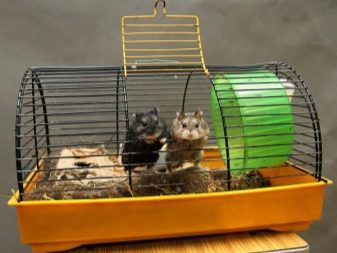How to find a hamster in an apartment if he escaped from a cage?

They are increasingly trying to breed various animals, including hamsters. But sometimes, instead of joy and fun, pets bring significant problems. Therefore, you need to know how to solve these difficulties.

Why does the hamster run away?
An escaped rodent must be sought immediately. After all, even what neither people nor highly organized animals (cats and dogs) usually pay attention to is very dangerous for him. The reasons why the hamster goes for a walk around the apartment are as follows:
- insufficient reliability of the cell;
- an attempt to hide from real or perceived danger;
- loud sounds (they scare the rodent);
- interest (especially typical for the Dzungarian breed, less for the "Syrians");
- fatigue;
- careless handling.


The hamster is an inquisitive animal, he often tries to get out not in order to cause problems to the owners, but because he is interested in everything in the world around him.... But it also happens otherwise: the rodent wants to sleep or is physically tired, but they take it out and make it play. Then instinct tells the animal to look for any opportunity for escape and rest. True, this situation is unlikely to fully correspond to the description of "escaped from the cage."
And the most serious reason for escapes is the carelessness of the owners. A wild beast is a wild beast: whenever control is weakened, it immediately takes advantage of the situation. Escape options are different:
- exit through the roof;
- opening a weakly reinforced door;
- destruction of plastic walls with teeth.


How to find?
Hamster owners often have very different ideas about this. Someone begins to feverishly inspect and ransack the entire home. Some people believe that you can just leave the animal alone.As if it will return to its place after a walk and all that remains is to put it in a cage. It is imperative that you try to find the hamster, lure it out and immediately catch it.
The fact is that the home environment for an inhabitant of dry steppes contains many dangers, primarily of the following:
- paws of cats;
- getting stuck in crevices and holes;
- hunger and thirst.

Therefore, if a hamster is lost at home, you must act immediately. But only without panic and rash throwing. They only tire and exhaust, and they rarely solve the problem. A well-tamed animal usually responds with characteristic sounds when its name is pronounced. You can help the call by shaking the container with food or rustling the bag with it.
The same should be done in the event that the hamster has not yet learned a certain name. He must react to food... However, it must be understood that an unusual situation can disrupt the normal reactions of the animal. His nervous system sometimes does not cope with the abundance of unusual stimuli or reacts to them in a bizarre way. Therefore, you need to know the correct search tactics if the hamster does not respond to the call.
Rodents of almost all breeds behave the same way. They cannot remain motionless for a long time. If you remove all noises in the house and listen, you can almost certainly find typical rustles. They are used to find hamsters hiding in hard-to-reach places.
Important: when searching, you should move with caution, without making additional noise.

It so happens that it is impossible to figure out where to look for a hamster. In this case, it is necessary be sure to block all the cracks and even small holes through which the animal can escape into the street.
But first of all, you need to carefully examine such places. It is likely that the rodent settled there. Only after checking can the passages be sealed with adhesive tape. Of course, the windows and doors should be locked.
There are other subtleties as well. The hamster is active at night and the hunt is best done after dark. In all rooms, seeds or other food are poured onto the floor. Sooner or later, a hungry animal will come out to them to eat.
It is not necessary to sit and wait all night near the bait. You can simply sprinkle flour around the same seeds. The hamster will not eat it, but will leave traces. You can also lay out plastic bags, or better foil. Then each movement of the legs will create a characteristic rustle.


Having found the escaped person, one must also catch him correctly. Even food bait must be used skillfully. It is advisable to have two cages: one is left in the usual place, and the other is where they go to catch a rodent. Delicious fresh food should be kept in the cage and updated regularly. Rolls of toilet paper rolls are placed nearby: often the animals climb into them and rest.
Furry pets are also attracted by the rides. They put a wheel in the room. As soon as it is discovered that he is interested in the toy, he began to rustle, he must go in search. Animal emerged from the shelter cover completely with a towel. This technique allows you to stop movement without causing harm.
Carefully take the hamster towel and place it in the cage. The towel is removed and the door is closed immediately.
In a private house and in the country, you need to act as quickly as possible. There, literally every minute of delay can turn into a hamster leaving for the street. Searching for him outside the home makes little sense.


To catch an animal, sleeves are used not only from toilet paper, but also from disposable towels. There is no need to be afraid: these improvised means are completely safe for a rodent. Moreover, if the hamster is not used to the hands, the sleeve will be the perfect help. The original way of capturing is as follows:
- put something tasty in the tube (to the taste of the hamster, of course);
- clog the entrance on one side;
- put an open edge where they intend to find a hiding rodent;
- as soon as he appears, close the entrance with his palm and return the escaped pet back.



A plastic bottle is also used for fishing. The best containers - with a capacity of 2 liters, which have flat walls. The bottom is cut off, and the folded top is secured with an elastic band. From below, a bridge is placed along which the hamster can climb into the bottle. A nut is placed inside, which will attract the attention of a rodent with its aroma.
Sometimes impromptu traps are made from buckets. Hay or sawdust is spread at the bottom. Put paper on top, and something tasty under it. An unnecessary ruler, a stack of old documents, and so on are suitable as a ladder.
A seed is placed after 2 steps. Once in the bucket, the hamster will not hit (thanks to the shock-absorbing straw) and will not get out.

If there are other animals in the apartment besides the hamster, you need to remove them away from the place where the fugitive may be. Isolating cats is especially important.
If there are mouse traps or rat traps in the house, they should be removed immediately. The hamster who has run into some room is isolated (the doors are closed). By the way, you can look for an animal in the folds of outerwear, in towels or in bedding (where it gets warm).

Where can he hide?
A pet hiding from a cage or from the hands of a pet is looked for in the same way. First, they study properly all the "secret" places where he can be in hiding. The faster this is done, the less effort will be spent on the search as a whole. First of all, they check:
- everything that is near the cage;
- places under sofas, wardrobes, chairs, armchairs, and so on;
- cabinets themselves, boxes, boxes and other containers.

The hamster who has climbed into the box is lured out of there with the help of "delicacies"... If the search for all the places described does not give any result, all other possible shelters should be checked.
It so happens that an animal is found, but it cannot be removed from there. In this case, an open cage with the preferred food is placed nearby. You can additionally play on the curiosity of the animal: pipes made of cardboard are placed on the floor and various labyrinths are built.
An instinctive interest in everything new often makes hamsters go to inspect such labyrinths. But you can't run out to meet him, it spoils the whole thing.
Cabinets and other furniture should be moved as carefully as possible. Excessive movement can be extremely dangerous for the hamster. If searches do not yield results for a long time, it is recommended to also examine the basements or lower floors.


How to prevent escape?
As you might guess, finding an escaped hamster can be long and difficult. Sometimes it is completely useless. Therefore, care must be taken to prevent escapes. Experienced people advise to systematically check the condition of the cells and immediately eliminate all problems. Pay special attention for the strength of the roof, rods, for the reliability of the door locking.
It is imperative to check whether the pet feels comfortable, whether something is annoying the hamster. He needs to devote more time. You cannot save on toys and on the arrangement of the cage. But these methods will only work with care and attention. One escape can still be attributed to an accident, but if they are repeated, something needs to be changed in the approach to the animal.
Every hole that the beast gnaws through must be closed. However, this is only a fight against the consequences, not the cause. It is recommended to keep the cage as far away from radio, TV or speakers as possible. It is necessary to strictly observe the daily routine that is convenient for the pet. If he was pulled out of the cage, one must carefully monitor each action continuously.



For information on what to do if the hamster escaped, see the next video.








